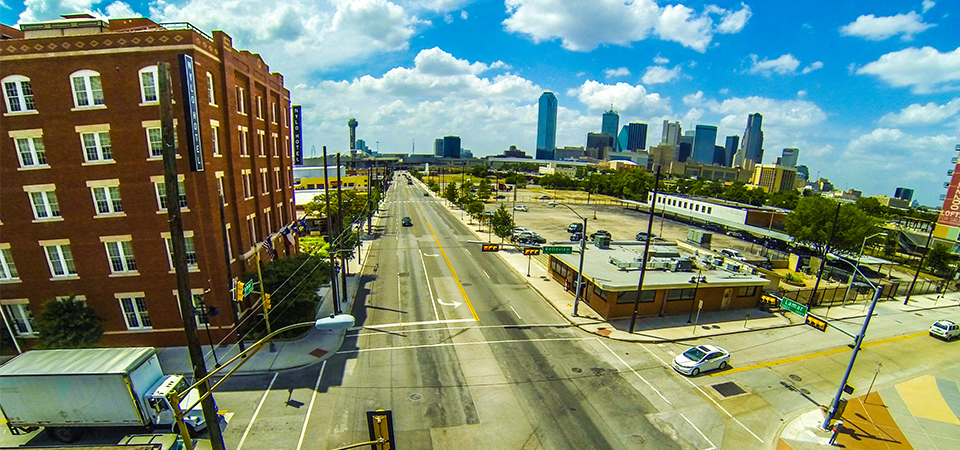Surrounded by the largest collection of 19th century pioneer and Victorian homes and commercial buildings in Texas at Dallas Heritage Village, TREC Young Guns gained five unique perspectives on the revitalization of one of Dallas’ oldest neighborhoods, the Cedars, at this year’s Forum. Panelists included Melissa Prycer, president and executive director of Dallas Heritage Village, Michael Sitarzewski, president of Cedars Neighborhood Association, Karl Stundins, area redevelopment program manager of City of Dallas – Office of Economic Development, Kristian Teleki, senior vice president – development at Matthews Southwest, and the evening’s moderator Kourtny Garrett, president of Downtown Dallas, Inc.
The Cedars’ Foundation
Bordering downtown Dallas’ southern boundary, it is no surprise the Cedars has experienced a series of economic cycles, cultural changes and development shifts. Since the early 1870’s, the area transitioned from prairie land to the home of Dallas’ wealthiest individuals to an industrial hub for heavy commercial businesses. It wasn’t until Matthews Southwest (MSW), a full-service private development company, acquired South Side on Lamar that the development momentum in the area recently launched. Kristian Teleki framed it perfectly when he said, “If you don’t know what you’re supposed to be afraid of, you can just plow through it.” And that is exactly what they did.
Despite the company’s willingness to tackle such a risky project, the full vision and success of the area has been a product of the collaboration between the private and public sector as well as the cultural and community-driven individuals focused on the area. Dallas Heritage Village has been a community advocate for 50 years and through the leadership of Melissa Prycer, the museum’s mindset has reoriented to connect with the change rather than protect from it. The goal was always to create interconnectivity within the Cedars and surrounding areas while maintaining the neighborhood’s integrity by developing with it rather than over it. Michael Sitarzewski describes that integrity as a rare combination of diversified individuals and businesses with a welcoming environment. The neighborhood has no resident profile, which ironically tends to be the biggest draw.
“Tipping Points” and Revitalization
The Cedars have experienced many “almost” moments that were often halted by difficult land acquisition processes or unsuccessful attempts to develop in the surrounding area, like Jerry Jones’ 2009 proposal to build the new Cowboys stadium at Fair Park. The Cedars’ progress existed, but occurred at a slower pace than most.
The panelists agreed the development momentum started with the $7.2 million TIF development program approved by the City of Dallas in 2011. Access to tax-revenue funds gave the neighborhood a spark. This was followed by additional residential development, a 3-acre land donation for the new Dallas Police Headquarters and entertainment venues like Gilley’s. Karl Stundins stands by the general rule that if you build it and they will come. The Cedars activity coupled with the new Omni Dallas Hotel gave North Dallas residents a reason to explore new areas of their city.
Future and “50 Year Impact Decisions”
Now that the Cedars revitalization is underway, our Forum panelists agree it is crucial going forward to bring differing perspectives together and determine a strategy to accomplish certain economic results without eliminating the Cedars cultural foundation. The idea is to add accretive assets to provide locals with an opportunity to succeed economically.
With the primary goal of connectivity, the next steps will revolve around transit-oriented development. The new high-speed rail corridor station connecting the Houston to Dallas in less than 90 minutes and the planned reconfiguration of Interstate 30 and its bridges will bring better access to the area from the freeways and downtown.
The improvements will inevitably condense downtown Dallas’ energy and encourage locals and visitors to explore eclectic neighborhoods like the Cedars. The increased traffic is sure to help support local establishments, spur organic growth and maintain the cultural drivers of the area. The success of neighborhoods like the Cedars is critical to Dallas as a community, will foster the generation of new workers and maintain the authentic nature of individual Dallas hubs.
What this Means to You
The Cedars revitalization is underway and as any young or seasoned real estate investor knows, location is everything. History confirms the most successful investors are those who identified the opportunity early and purchased land before high-demand drove prices upward. Property values in the Cedars will inevitability increase, thus the area is a prime location for investors to find manageable housing rates compared to the Uptown/Downtown area and for businesses looking to expand much like the neighborhood’s recent addition, Four Corners Brewing Co.
For those that wish to remain in the comfort zone that lies north of Downtown Dallas, we encourage you venture to the Cedars, support the local establishments and promote the organic growth all neighborhood advocates are striving for.
